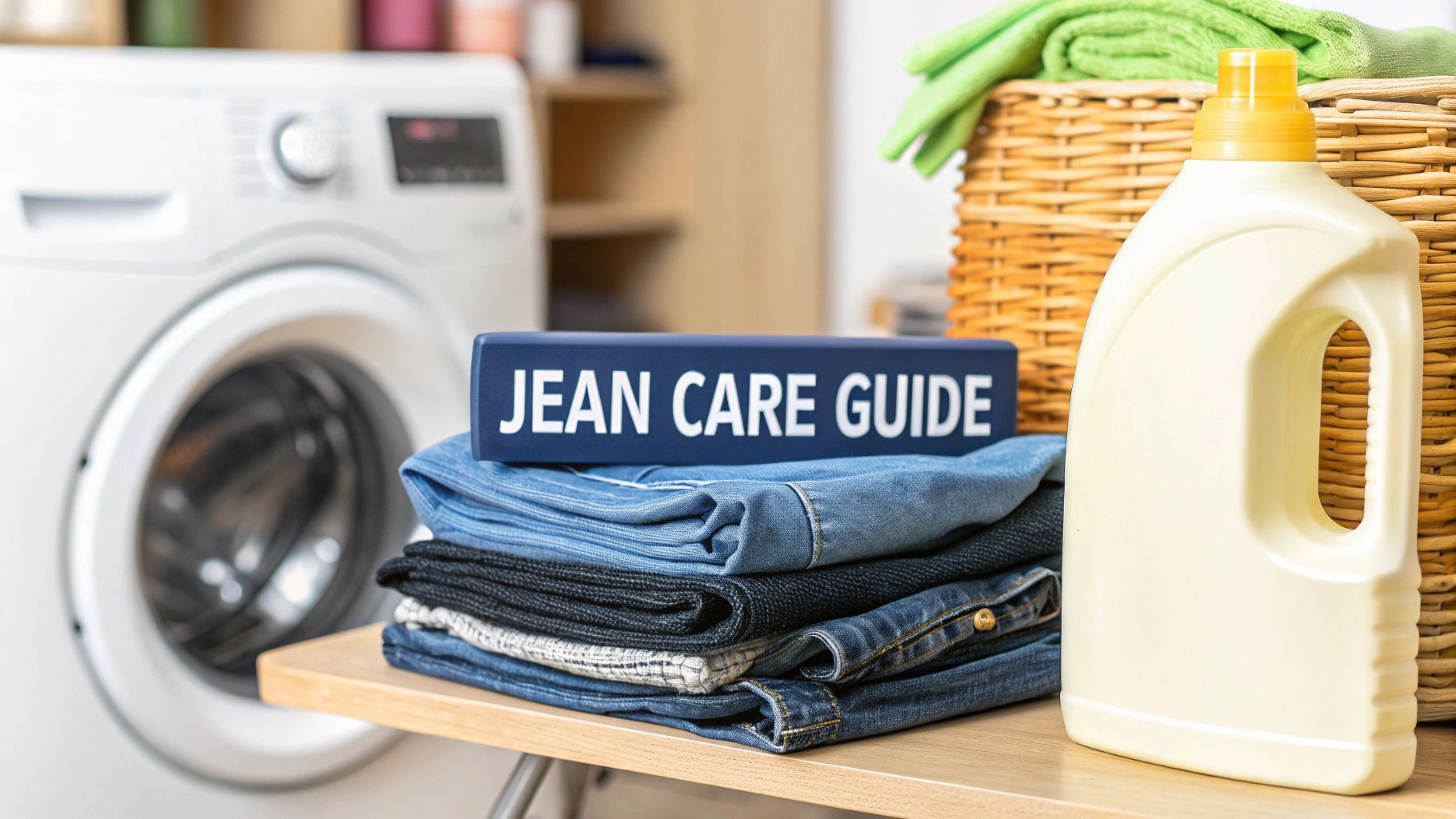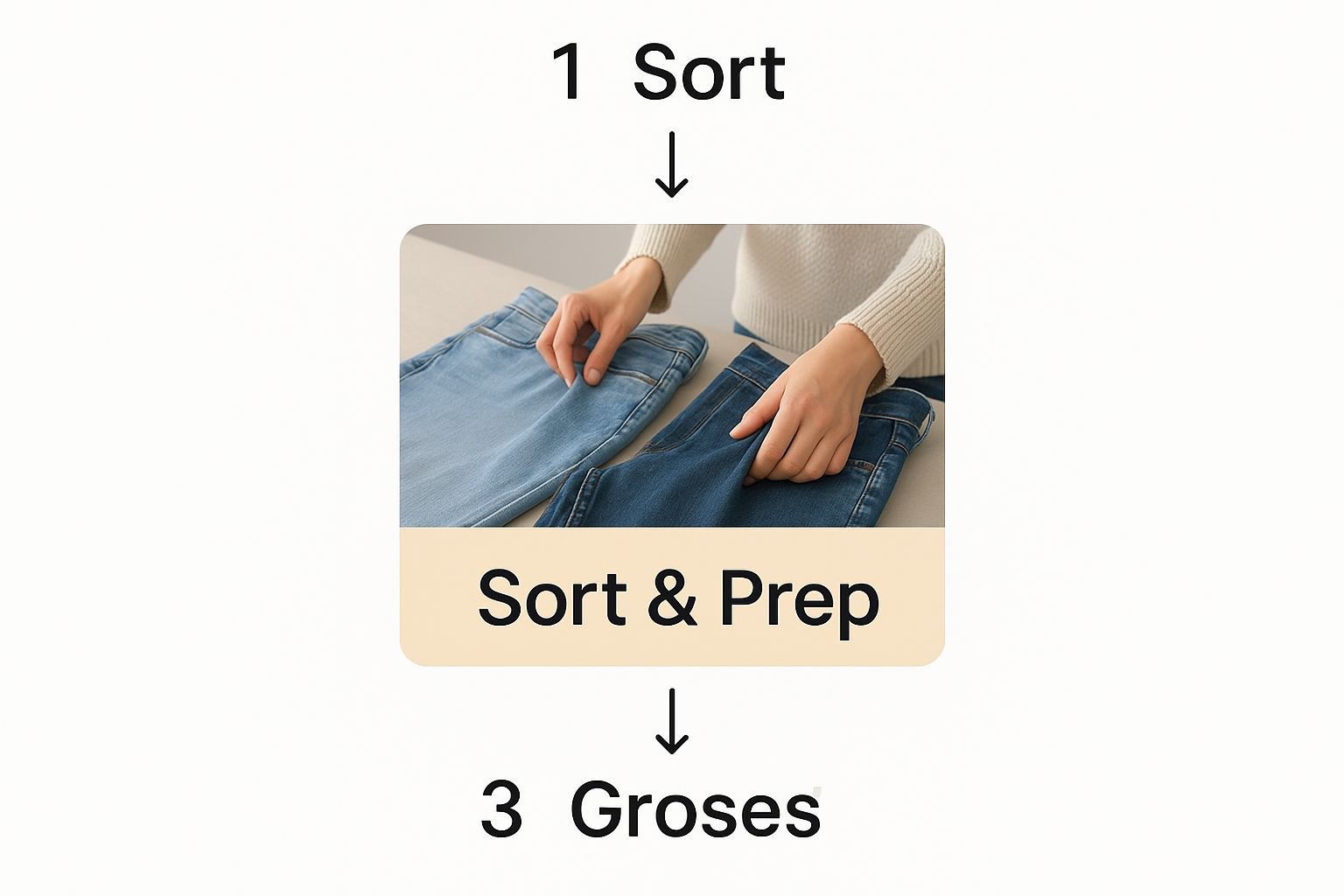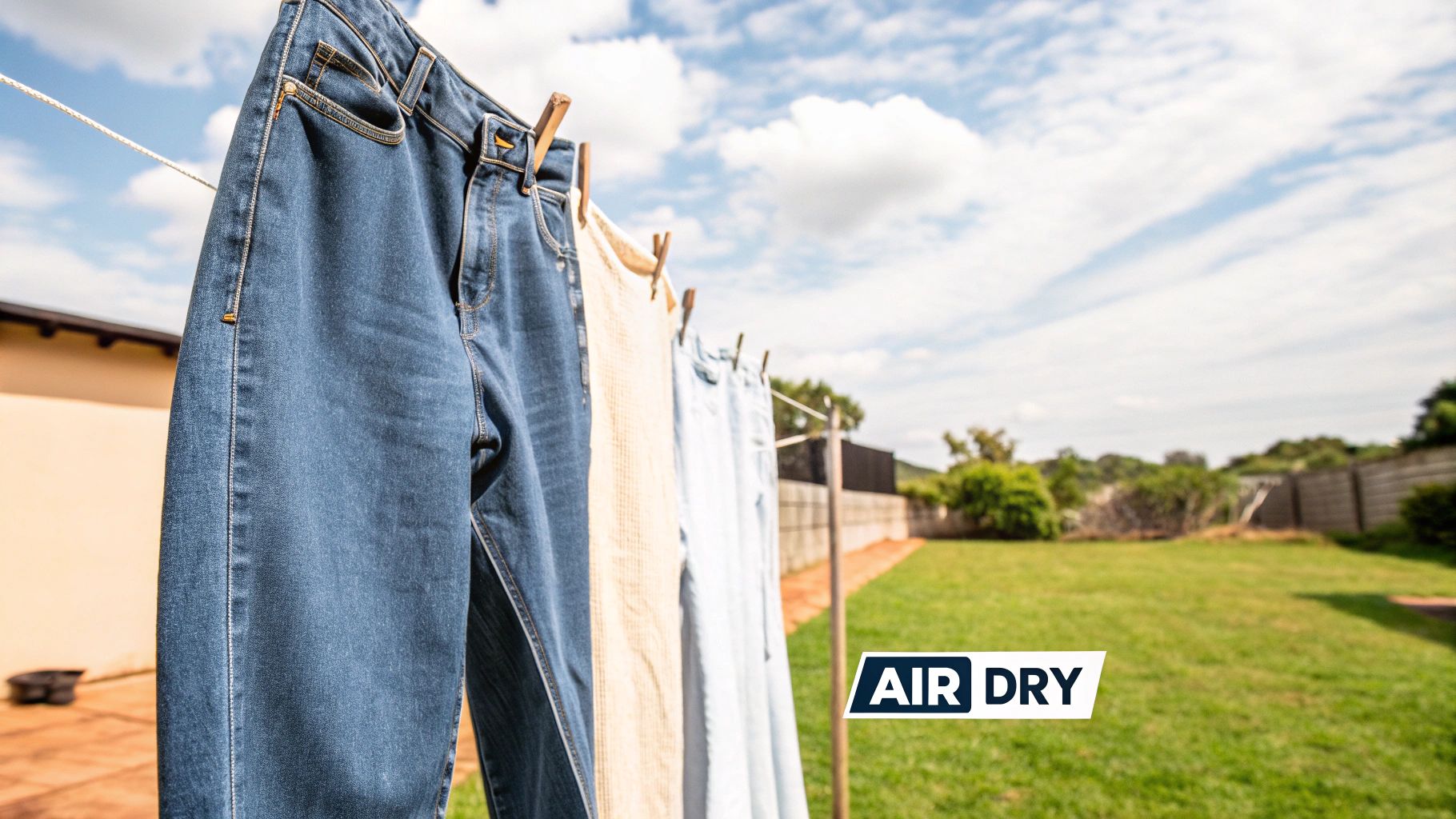How to Wash Jeans to Make Them Last

If you’ve ever wondered how to wash your favorite jeans, it’s beautifully simple: less is always more. The secret is to wash them infrequently, always turn them inside out, and use cold water on the gentlest cycle. This isn't just a random tip—it's the single best way to preserve the color, fit, and soul of your denim.
Why Your Jean Washing Method Matters
It’s tempting to just toss your jeans into the laundry pile without a second thought, but how you wash them directly shapes how they’ll look and feel for years. A careless approach—think hot water, aggressive cycles, and constant washing—is the fastest route to ruining a pair you absolutely love. It’s what causes that rich indigo to fade, the fibers to weaken, and that dreaded shrinkage that turns a perfect fit into something tight and unforgiving.
Proper care is really about protecting an investment. When you finally find that one pair that feels like it was made for you, the last thing you want is to shorten its life.
The Real Cost of Poor Washing Habits
Every time your jeans go through a wash cycle, they’re being subjected to a surprising amount of friction and stress. All that tumbling strips away the indigo dye, leaving a once-vibrant blue looking dull and tired. Even worse, the heat from a hot wash or a spin in the dryer actively breaks down the cotton and elastane fibers, which is why jeans lose their shape and that soft-yet-sturdy feel.
Getting that fit right is everything, and learning how to maintain it is just as important. For more on finding that perfect silhouette, you can dive into our complete jeans fit guide.
To really nail your denim care routine, it helps to keep a few core principles in mind. I've put together a quick reference table to make it easy.
Quick Guide to Smart Denim Care
| Washing Principle | Why It's Important |
|---|---|
| Wash Infrequently | Preserves the natural fade and prevents unnecessary wear and tear on the fibers. |
| Use Cold Water Only | Protects the indigo dye from fading and stops the cotton fibers from shrinking. |
| Turn Jeans Inside Out | Reduces friction on the outside of the denim, minimizing color loss and protecting details. |
| Choose a Gentle Cycle | The slow spin and gentle agitation are less stressful on the seams and fabric. |
| Air-Dry Whenever Possible | Avoids the high heat of a dryer, which can damage elastane and cause shrinkage. |
Think of these as the golden rules for making your denim last. It's a simple shift in habit that makes a world of difference.
By treating your denim with care, you're not just making a practical choice for your wardrobe, but also a responsible one. You extend the life of your clothing, reducing waste and consumption.
This mindful approach has a bigger impact than you might think. The denim market is massive and continues to grow, so small changes in how we care for our clothes can add up. Extending the life of a garment is one of the most powerful and sustainable things you can do. For anyone curious about the industry's scale, PR Newswire offers some fascinating insights into the denim market's growth.
A Practical Guide to Machine Washing Jeans
Tossing your jeans in the washing machine is undeniably the easiest route to clean, but there’s a bit of an art to it if you want them to last. I’ve learned over the years that one simple trick makes all the difference: turn every single pair inside out before they hit the drum. It’s a small thing, but it’s what protects that outer fabric from friction, keeping the color rich and stopping zippers from snagging on everything else in the load.
Next, I always run my jeans with other darks. This is non-negotiable, especially for new indigo denim. The dye can—and will—bleed for the first few washes, and you don’t want your favorite white tee to pay the price.

Think of that prep work as the foundation. Get that right, and you've set your favorite pair up for a long, happy life.
Choosing the Right Settings and Detergent
Once your jeans are prepped and ready, the machine's settings are your next line of defense. I can't stress this enough: always, always use the cold water setting. Hot water is the number one enemy of denim, causing both fading and shrinking, particularly in jeans with a bit of stretch. I also stick to the gentlest cycle my machine offers to minimize the stress on the fabric’s fibers and seams.
When it comes to soap, a mild, color-safe detergent is your best friend. Steer clear of harsh chemicals or using too much soap, since the leftover residue can make cotton feel stiff and scratchy over time.
For my really special pairs—the ones with delicate embroidery or cool distressed details—I tuck them into a mesh laundry bag. This gives them an extra buffer against the tumbling, protecting all those little things that make the jeans unique.
Ultimately, having the right appliance can make all this effortless. If you’re not sure your machine has the right features for proper denim care, it’s worth checking a comprehensive washing machine buying guide to explore what's out there. This mindset of preserving your pieces is a game-changer for everyone, including those searching for the best jeans for women over 60 who value both great style and long-lasting quality.
Hand Washing Your Jeans: The Ultimate Preservation Method

For those truly cherished pairs—your raw denim, that perfect vintage find, or jeans with delicate embroidery—hand washing is less of a chore and more of a loving ritual. It's the absolute best way to ensure they live a long, beautiful life. While it sounds involved, the process is surprisingly simple and almost meditative. It’s my personal method for protecting the deep, rich indigo and perfect shape of my most-loved denim.
First, fill a clean bathtub or a large basin with cold water. I can't stress this enough—hot or even lukewarm water will encourage the dye to bleed and the cotton to shrink. Stick to cool temperatures to be safe.
Next, add a very small amount of a gentle, denim-safe detergent. You need far less than you’d think. A teaspoon or two is usually all it takes. Give the water a good swish to make sure the soap dissolves completely before you introduce your jeans.
The Gentle Soak and Rinse
Now for the main event. Turn your jeans inside out and submerge them completely in the soapy water. You might need to press them down a bit until they're fully saturated.
The key here is patience. Just let them soak for about 45 minutes. This quiet time does most of the heavy lifting for you, gently loosening dirt and oils from the fibers without any harshness.
After the soak, it's time to agitate them, but gently. Forget scrubbing—that’s a surefire way to create fade lines and wear. Instead, just swish the jeans through the water for a minute or two. This subtle movement is more than enough to dislodge any lingering grime.
The goal of hand washing isn't to scrub your jeans into submission. It's to gently coax the dirt out while preserving the fabric's unique character and color.
Drain the tub and refill it with fresh, cold water to rinse. Repeat the swishing motion until all the soap is gone. You’ll know you’re done when the water runs clear, with no suds in sight.
To get the excess water out, please do not twist or wring your jeans. This is the quickest way to damage the fibers and completely distort their shape. A much better approach is to gently press the water out against the side of the tub. Or, my favorite trick: roll them up tightly in a thick, clean towel and press down on the roll with your body weight. This absorbs a ton of moisture without stretching out that fit you’ve worked so hard to perfect.
How to Dry Jeans Without Shrinking Them
https://www.youtube.com/embed/ghZh2P_NSmA
So you’ve carefully washed your favorite pair of jeans. But the real moment of truth, where so many good intentions go astray, happens right at the end: the drying. That intense, blasting heat from a machine dryer is the number one enemy of denim, causing the kind of irreversible shrinkage and fading we all dread.
High heat essentially cooks the cotton and elastane fibers, leaving them brittle and warped. Over time, that perfect fit you loved is gone for good. That's why air-drying will always be your best friend. It's the gentlest way to dry your denim and the only method that truly guarantees your jeans will keep their original size, shape, and color.
The Best Way to Air-Dry Your Jeans
Believe it or not, there's an art to air-drying. Just tossing a wet pair of jeans over a chair can leave you with awkward creases and can even stretch out the fabric in weird ways.
For a perfect, even dry every time, keep these tips in mind:
- Hang Them From the Waist: The best way to do this is with a sturdy hanger that has clips. Alternatively, you can hang them by the belt loops. This lets air flow freely through the legs and prevents the weight of the wet denim from stretching them out of shape.
- Keep Them Inside Out: Just like when you washed them, keep your jeans turned inside out while they dry. This simple step is huge for protecting that beautiful indigo dye from fading, especially if they’re drying near a window.
- Find Some Shade: Direct sunlight acts like a natural bleach, and it will absolutely strip the color from your denim. A well-ventilated spot away from the sun is the perfect place for them to hang out.
If You Absolutely Must Use a Dryer
Look, sometimes life happens and you need your jeans dry now. If you have no other choice but to use a machine, treat it as a last resort.
Always use the lowest heat setting possible. Even better? Use the no-heat, air-fluff cycle for just 10 minutes to help soften them up a bit, then pull them out while they're still damp and hang them to finish drying. Taking these little steps can also help you appreciate a pair of truly soft denim jeans that feel incredible right from the very first wear.
Common Jean Washing Mistakes to Avoid
Even with the best of intentions, it's easy to slip into laundry habits that slowly wear out your favorite denim. Knowing how to wash your jeans is just as much about what not to do as it is about what you should. Let’s talk about a few common missteps that might be secretly sabotaging your wardrobe.
One of the biggest culprits? Fabric softener. It sounds like it would make your jeans softer, but it actually does the opposite over time. Softeners leave behind a waxy film on the cotton fibers, which builds up and makes the fabric feel stiff and strangely slick, not cozy and broken-in. The best way to get that perfectly soft feel is to just let your jeans soften naturally with wear.
Another mistake I see all the time is washing jeans in warm or hot water. That heat is way too aggressive for indigo dye, stripping it right from the fibers and leaving you with a faded, washed-out look much faster than you’d want. Hot water also causes the cotton to constrict and shrink. This is especially bad news for stretch denim, as it can permanently damage the elastane and completely ruin the fit.
Overlooking Stains and Overcrowding the Machine
Perhaps the most damaging habit of all is letting a stain sit until laundry day. Whether it's a coffee spill on your morning commute or a grass stain from a weekend picnic, letting it linger gives it time to bake into the fabric for good. Always spot-treat stains immediately with a gentle stain remover before they have a chance to set.
Finally, resist that temptation to cram every pair of jeans you own into a single load. When the machine is overcrowded, water and detergent can't circulate properly, meaning your jeans never get truly clean. It also creates a ton of friction between the pairs, which leads to more color loss and unnecessary wear on the fabric. Give your denim some breathing room—it’ll thank you with a gentler, more effective clean.
Mindful washing does more than just protect your jeans; it has a significant environmental impact. Each small change in your routine contributes to a much larger conservation effort.
Think about it: producing just one pair of jeans requires a staggering amount of resources. With the global denim market moving over 1.24 billion pairs a year, simple shifts like using cold water and washing less often can lead to massive water and energy savings. You can discover more about these denim sustainability statistics and see just how much those small changes add up. These smart habits not only preserve your denim's fit and color but also help prevent issues like that annoying waistband gap, which you can learn more about in our guide on how to fix a jeans gap in the back.
Your Questions About Washing Jeans Answered

Even after you think you've perfected how to wash jeans, little questions always seem to pop up. This is where we can dig into the most common ones I hear, settling the great debates and giving you clear, practical answers for taking care of your denim.
We'll cover everything from how often you really need to wash them to busting that old freezer myth once and for all. My goal is to help you feel completely confident with every pair you own, from your oldest favorites to a brand-new find.
How Often Should I Really Wash My Jeans?
Honestly? As little as possible. Most denim experts I know suggest washing your standard jeans only after about 5 to 10 wears. For raw denim, many enthusiasts will go months without a single wash to get that perfectly molded, personalized fade.
The real rule of thumb is simple: wash them when they're visibly dirty or start to smell. In between, airing them out or spot-cleaning a minor spill is your best friend. It turns out around 21% of people already wear their jeans at least five times before a wash, which lines up perfectly with this advice.
Does Putting Jeans in the Freezer Actually Clean Them?
This is a popular myth that definitely needs busting. While popping your jeans in the freezer might make odor-causing bacteria go dormant for a little while, they'll wake right back up once your denim returns to room temperature.
A university study confirmed that freezing doesn't effectively kill the bacteria on your jeans. It’s a temporary fix at best and does nothing to remove the actual dirt, oils, or skin cells that have built up.
For a true clean, you need a proper wash. Even just airing them out in the sun (inside out, of course) is a much better way to freshen them up.
What Should I Do About New Dark Jeans That Bleed Dye?
Dye bleeding, or "crocking" as it's sometimes called, is incredibly common with new, dark-wash denim. I always recommend a simple pre-soak before the first wear to keep your other clothes and furniture from turning blue.
Just fill a tub with cold water, add about a cup of white vinegar, and let the jeans soak inside out for at least an hour. The vinegar is great for helping set the dye. Afterwards, give them a good rinse with cool water until it runs clear. For the first few real washes, it's safest to launder them alone or with other very dark items.
At JAG Jeans, we design denim that fits into your life effortlessly, with timeless styles and comfortable stretch fabrics that feel perfect from the first wear. Explore our collection to find your next favorite pair. Discover your perfect fit on jagjeans.com.
Recent Blogs
How to Wash Jeans to Make Them Last
Learn how to wash jeans the right way to protect...
How to Wash Jeans to Make Them Last
Learn how to wash jeans the right way to protect...
How to Wash Jeans to Make Them Last
Learn how to wash jeans the right way to protect...